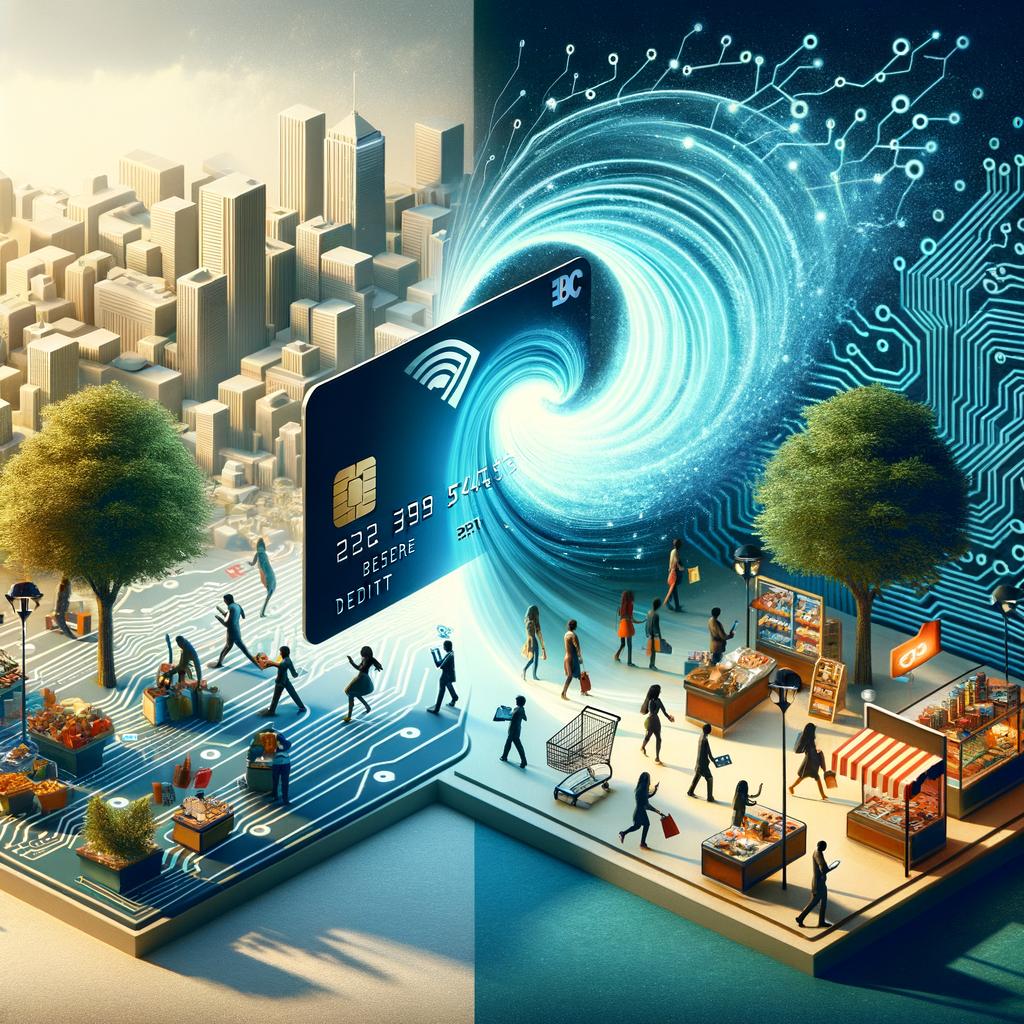Card Payments Technology and Innovation
Card Payments Technology and Innovation: Latest advancements in card processing technology, contactless payments, mobile processing, and future trends.
Tokenization in payment processing is like the secret agent of the cybersecurity world. It’s the unsung hero that swoops in to protect your sensitive data from falling into the wrong hands. Picture this: you’re making a purchase online, entering your credit card information with a slight twinge of anxiety. But fear not, because tokenization is here to save the day.
So, what exactly is tokenization? Think of it as a cloak of invisibility for your credit card details. When you make a payment, your information gets scrambled into a unique token – a randomized string of numbers that holds no value to hackers. This token is like a decoy, standing in for your actual data as it travels through the digital realm. Even if a cybercriminal were to intercept it, they’d just end up with a useless jumble of characters.
But tokenization doesn’t just stop at protecting your credit card info. It also minimizes the risk of data breaches for merchants. By replacing sensitive data with tokens, companies can store information securely without the fear of it being stolen. This means that even if a hacker were to breach their system, all they’d find are those harmless strings of numbers.
In addition to enhancing data security, tokenization also streamlines the payment process. Because tokens are reusable, customers can make purchases without having to re-enter their information each time. It’s like having a VIP pass to the checkout line – quick, convenient, and hassle-free.
So, the next time you buy something online, take a moment to thank tokenization for keeping your financial details safe and sound. It may not wear a cape or a mask, but it’s definitely a hero in the world of payment processing.
In a world where technology is constantly evolving, it’s no surprise that even something as small as our credit cards are getting a major upgrade. Enter EMV chip technology – the latest and greatest in the world of secure payment methods.
Gone are the days of swiping your card and holding your breath, hoping that your information doesn’t get stolen. With EMV chip technology, your data is encrypted and securely stored on a tiny chip embedded in your card. So, what makes this technology so special? Let’s take a look at the evolution of EMV chip technology and the enhancements and innovations that have come along with it.
First introduced in the early 2000s, EMV chip technology has come a long way since its inception. The initial version of the chip was somewhat bulky and cumbersome, making it less than ideal for everyday use. However, as technology advanced, so did the design of the chip. Today, EMV chips are sleek, slim, and seamlessly integrated into the card itself – making them practically invisible to the naked eye.
But it’s not just the physical appearance of the chip that has evolved over the years. The technology itself has also seen significant improvements. Early versions of the chip were susceptible to hacking and fraud, but advancements in encryption and security protocols have made EMV chips virtually impenetrable to would-be thieves. With features like dynamic authentication and tokenization, your data is safe and sound – no matter where you swipe your card.
In addition to enhanced security measures, EMV chip technology has also opened the door to a world of innovation in the world of payments. Contactless payment options, like Apple Pay and Google Wallet, have become increasingly popular in recent years, allowing users to simply tap their card or phone to complete a transaction. And with the rise of online shopping, EMV chips have made it easier than ever to securely make purchases from the comfort of your own home.
As we look to the future, the possibilities for EMV chip technology are endless. From biometric authentication to real-time fraud detection, the evolution of the chip is showing no signs of slowing down. So next time you pull out your card to pay, take a moment to appreciate the tiny piece of technology that’s keeping your data safe and secure. The evolution of EMV chip technology is truly something to marvel at.
In a world where convenience is key, contactless payments are revolutionizing the retail experience as we know it. No longer do we have to fumble for cash or swipe cards – a simple tap or wave of a phone or card is all it takes to complete a transaction. With the rise of technology, contactless payments are becoming more prevalent in stores, restaurants, and even public transportation systems.
Gone are the days of waiting in long lines while customers fumble for change or search for their credit card in their wallets. Contactless payments offer a seamless and efficient way to make purchases, saving both time and hassle for both customers and businesses alike. With just a quick tap, customers can now pay for their items and be on their way in a matter of seconds.
But beyond the convenience factor, contactless payments also offer a more secure way to complete transactions. With the use of encryption technology and tokenization, contactless payments are more secure than traditional swipe or chip-and-pin methods. This added layer of security helps to protect customers from fraud and identity theft, giving them peace of mind when making purchases.
The retail landscape is constantly evolving, and contactless payments are at the forefront of this transformation. As more and more businesses adopt this technology, customers can expect to see a shift in the way they shop and pay for goods and services. Contactless payments are not only changing the way we make purchases, but also how we interact with retailers and businesses.
So the next time you find yourself in line at a store, consider using contactless payments for a faster, more secure, and overall improved retail experience. Embrace the convenience and efficiency of contactless payments, and see how they are transforming the way we shop in today’s digital world.
In the modern world of retail, where brick-and-mortar stores, e-commerce platforms, and mobile apps all coexist, the importance of payment gateways cannot be overstated. These digital tools serve as the crucial link between customers and businesses, ensuring that transactions are smooth, secure, and convenient across all channels.
Imagine this scenario: you walk into a quaint boutique in town and find the perfect dress for an upcoming event. You proceed to the counter, eager to make your purchase. However, when you reach for your credit card, the cashier informs you that they only accept cash payments. Frustrated, you leave the store empty-handed, vowing never to return.
Now, contrast this with a different scenario: you browse your favorite online retailer’s website and add several items to your cart. When you’re ready to check out, you simply enter your payment information into the secure gateway, and voila! Your order is processed, and the items are on their way to your doorstep.
In the first scenario, the lack of a digital payment gateway hinders the customer experience and ultimately leads to lost sales for the business. In the second scenario, the seamless integration of a payment gateway enables smooth transactions and boosts customer satisfaction.
But it doesn’t end there. In today’s omnichannel retail landscape, where customers expect a seamless shopping experience across all touchpoints, the significance of payment gateways is even more pronounced. Whether a customer is browsing in-store, online, or on a mobile app, they should be able to make a payment easily and securely.
Moreover, payment gateways play a crucial role in data security, protecting sensitive customer information from cyber threats and ensuring compliance with industry regulations. By encrypting payment details and verifying transactions in real-time, these gateways provide peace of mind to both businesses and customers.
In conclusion, payment gateways are the unsung heroes of the retail world, facilitating transactions, enhancing customer experience, and safeguarding data. As technology continues to evolve and consumer expectations rise, businesses must prioritize the integration of robust payment gateways to stay competitive in the omnichannel landscape. After all, in a world where convenience is king, a seamless payment experience can make all the difference between a one-time sale and a loyal customer for life.
Imagine this scenario: you come home from a long day at work, eager to relax and unwind. As you step through the door, your smart home devices spring into action. The lights dim to a soft, warm glow, your favorite music starts playing, and the air conditioner adjusts to the perfect temperature. But what if, instead of just setting the mood, your smart home devices could also handle your payments seamlessly?
The integration of payment processing in smart home devices is a game-changer in the world of technology and innovation. No longer do you need to fumble for your wallet or juggle multiple apps to pay for services and products. With just a few simple voice commands or taps on your smartphone, you can make payments effortlessly as your smart home devices take care of the rest.
Whether you’re ordering groceries, booking a cleaning service, or purchasing new furniture for your home, payment processing in smart home devices streamlines the entire process. Imagine being able to add items to your shopping cart simply by telling your virtual assistant, or paying for services with the touch of a button on your smart speaker. It’s convenience at its finest, tailored specifically to your lifestyle and needs.
But how does payment processing in smart home devices work, you may ask? It’s all about the seamless integration of technology and connectivity. Through secure payment gateways and encrypted communication channels, your smart home devices are able to process payments efficiently and securely. This means no more worrying about the safety of your financial information or the hassle of manual transactions.
The benefits of integrating payment processing in smart home devices are endless. Not only does it simplify your daily tasks and save you time, but it also enhances the overall smart home experience. Imagine being able to seamlessly transition from controlling your home environment to managing your finances with just a few clicks or commands. It’s the ultimate convenience at your fingertips.
As technology continues to evolve and become more integrated into our daily lives, the possibilities for payment processing in smart home devices are endless. Whether it’s through biometric authentication, voice recognition, or artificial intelligence, the future of payments in the smart home is boundless. So sit back, relax, and let your smart home devices take care of the rest – including your payments. The future is here, and it’s as easy as saying “Alexa, pay for it.
As technology continues to revolutionize our world, one of the most exciting developments in recent years has been the rise of mobile wallets. Gone are the days of fumbling through your purse or wallet to find the right card or cash – now, all you need is your phone.
But what does this mean for consumers and businesses alike? Let’s take a closer look at the impact of mobile wallets on our everyday lives.
For consumers, mobile wallets offer a convenient and secure way to make payments on the go. With just a few taps on your phone, you can easily pay for groceries, order a ride share, or even split the bill with friends. No more worrying about carrying around multiple credit cards or remembering to bring cash – everything you need is right at your fingertips.
But the benefits of mobile wallets extend beyond just convenience. They also offer enhanced security features, such as fingerprint or face recognition, to help protect your financial information from potential hackers. Plus, with the ability to store loyalty cards and receive personalized offers and discounts, you can save both time and money while shopping.
On the business side of things, mobile wallets present a unique opportunity to attract and retain customers. By offering a seamless and hassle-free payment experience, businesses can increase customer satisfaction and loyalty. Additionally, mobile wallets enable businesses to track customer spending habits and preferences, allowing them to tailor their marketing efforts and drive sales.
But perhaps the most exciting aspect of the rise of mobile wallets is the potential for innovation and growth in the financial technology industry. As more consumers embrace mobile payment solutions, we can expect to see new features and functionalities that will continue to improve the overall user experience.
So whether you’re a consumer looking for a convenient way to pay, or a business looking to stay ahead of the curve, it’s clear that mobile wallets are here to stay. Embrace the future of payments with mobile wallets and enjoy a more seamless and secure shopping experience.
In a world where everything is becoming digital, it’s no surprise that payment processing is also undergoing a major transformation. Traditional models of payment processing that rely on intermediaries like banks and credit card companies are being disrupted by the innovative technology known as blockchain.
So, what exactly is blockchain and how is it changing the way we make payments? In simple terms, blockchain is a decentralized, distributed ledger that securely records transactions across a network of computers. This means that transactions are verified and recorded without the need for a central authority, providing greater transparency and security.
One of the key benefits of blockchain in payment processing is the removal of intermediaries, leading to faster processing times and lower fees. With blockchain, payments can be made directly between parties, cutting out the need for banks or credit card companies to facilitate transactions. This not only streamlines the payment process but also reduces costs for both merchants and consumers.
Furthermore, blockchain technology is inherently secure, making it more difficult for fraudulent activities to occur. Each transaction is recorded on a block that is linked to the previous one, creating a chain of secure and immutable data. This makes blockchain an ideal solution for industries where security and transparency are paramount, such as finance and healthcare.
Another advantage of blockchain in payment processing is its ability to facilitate cross-border transactions with ease. Traditional methods of transferring money internationally often involve high fees and long processing times. With blockchain, payments can be made in real-time regardless of geographical location, making it ideal for businesses operating on a global scale.
Overall, the impact of blockchain on payment processing is undeniable. As more businesses and consumers adopt this technology, we can expect to see a shift towards more efficient, secure, and cost-effective payment solutions. With blockchain leading the charge, the future of payment processing looks brighter than ever.
In a world where instant gratification is the norm, waiting days for transactions to process seems like a thing of the past. Real-time payments are revolutionizing the way we exchange money, redefining speed and efficiency in transactions like never before.
Imagine this: you’re at a bustling coffee shop, and you realize you forgot your wallet at home. No need to panic – thanks to real-time payments, you can easily transfer money to your friend who’s standing in line to grab your order. Within seconds, the funds are in their account, and your coffee craving is satisfied. It’s that simple and that fast.
Real-time payments have become the new standard for businesses, consumers, and financial institutions alike. Gone are the days of waiting hours or even days for a transaction to go through. With real-time payments, money can move from one account to another in a matter of seconds, no matter the time of day or day of the week.
The benefits of real-time payments are endless. For businesses, it means faster access to funds, quicker reconciliation of payments, and improved cash flow. For consumers, it means greater convenience, enhanced security, and instant access to funds. And for financial institutions, it means increased customer satisfaction, reduced risk, and improved operational efficiency.
But the impact of real-time payments goes beyond just speed and efficiency. It’s also about driving innovation and shaping the future of financial services. With real-time payments, new business models can emerge, and new products and services can be developed to meet the evolving needs of consumers in a world that’s constantly changing and evolving.
So, the next time you’re making a payment or transferring money, think about the power of real-time payments and how they’re redefining the way we do transactions. It’s a game-changer that’s here to stay, bringing speed, efficiency, and convenience to the forefront of the financial world. Get ready for a new era of money exchange – one that’s fast, seamless, and always on time.
Have you ever thought about what the future holds for card processing? With technology advancing at lightning speed, the way we pay for goods and services is constantly evolving. From contactless payments to digital wallets, the landscape of card processing is changing before our eyes.
One emerging trend to watch is the rise of mobile payments. More and more people are ditching their wallets in favor of their smartphones when it comes to making purchases. With the popularity of Apple Pay, Google Pay, and Samsung Pay on the rise, it’s clear that the future of card processing is moving towards a more convenient, digital form of payment.
Another trend to keep an eye on is the increasing use of biometric authentication in card processing. Gone are the days of pin numbers and passwords – with fingerprint and facial recognition technology becoming more widespread, the need for traditional security measures is decreasing. This not only enhances the security of transactions but also provides a more seamless and efficient payment experience for consumers.
Additionally, the concept of invisible payments is gaining traction in the world of card processing. This means that payments are made automatically in the background, without the need for any physical interaction from the consumer. Subscription services, online shopping, and even restaurant dining experiences are all moving towards this invisible payment model, making the checkout process faster and more convenient than ever before.
As we look towards the future of card processing, one thing is clear – technology will continue to shape the way we make payments. From mobile payments to biometric authentication and invisible payments, the ways in which we pay for goods and services are rapidly changing. So buckle up and get ready for a future where your wallet might just become a thing of the past.
QR Code Payments: Bridging the Gap Between Online and Offline Transactions
Hey there, tech-savvy folks! Have you ever wondered how businesses are making it easier for you to pay these days? Well, say hello to the fantastic world of QR code payments – the bridge that’s finally connecting our online and offline worlds. Trust me, once you dive into this, you won’t look back!
Now, picture this: you’re out and about, exploring the bustling city streets, when you suddenly spot a killer pair of sneakers in a store window. Instinctively, you whip out your trusty smartphone and start browsing prices online, only to realize they’re much cheaper than you anticipated. Eureka!
But wait, how do you pay for these fantastic kicks without going through the hassle of inputting payment details manually? Enter QR code payments, the ultimate game-changer!
Here’s the lowdown: a QR code, short for “Quick Response code,” is that fancy little black-and-white square filled with cryptic patterns that you’ve probably noticed popping up everywhere – from posters to magazines, and even on your favorite brand’s merchandise. It’s like a digital key that unlocks a world of convenience.
So, how does it work? Well, you simply scan the QR code using your phone’s camera or a designated app, and ta-da! You’re instantly linked to the payment page where all the relevant information is neatly listed. Forget about fiddling with credit card numbers or manually inputting billing addresses; this smart technology takes care of all the tedious details, making your life a breeze.
The beauty of QR code payments lies in their versatility. From street food vendors to high-end clothing boutiques, businesses of all shapes and sizes are hopping on the bandwagon and offering customers this seamless payment option. And why not? Traditional cash and cards can be a pain – cash disappears in a flash, and who wants to remember multiple PINs for different cards? QR codes eliminate all those drawbacks and effortlessly facilitate the transaction process.
But hold on, there’s more! QR code payments are also a win for businesses. By opting for this delightful innovation, they’re reducing transaction costs and streamlining operations. Plus, it provides them with valuable customer data to tailor their offerings and create loyalty programs. Whichever way you look at it, it’s a win-win situation!
Now, skeptics may worry about the security aspect. But fear not, dear readers! QR code payments have got your back. These digital marvels use encrypted technology, ensuring that you’re shielded from cyber threats. With that in mind, you can confidently wave bye-bye to fraudulent transactions and embrace the convenience of QR code payments wholeheartedly.
So, whether you’re indulging your shopping desires or grabbing a snack on the go, QR code payments are here to make your life a whole lot simpler. Say goodbye to the hassle of fumbling for cash or fishing out your wallet. Embrace this futuristic, user-friendly, and downright trendy method of payment. Start scanning those QR codes and unlock a world of convenience, effortlessly bridging the gap between online and offline transactions like never before.











